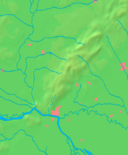Modra
| Modra | ||
| Town | ||
|
The "Upper Gate", the only remaining fortification gate in Modra
|
||
|
||
| Country | Slovakia | |
|---|---|---|
| Region | Bratislava | |
| District | Pezinok | |
| Elevation | 175 m (574 ft) | |
| Coordinates | 48°19′54″N 17°18′32″E / 48.33167°N 17.30889°ECoordinates: 48°19′54″N 17°18′32″E / 48.33167°N 17.30889°E | |
| Highest point | Veľká homoľa | |
| - elevation | 709 m (2,326 ft) | |
| Lowest point | ||
| - elevation | 144 m (472 ft) | |
| Area | 49.624 km2 (19.160 sq mi) | |
| Population | 8,704 (2005) | |
| Density | 175/km2 (453/sq mi) | |
| First mentioned | 1158 | |
| Mayor | Mgr. Juraj Petrakovič | |
| Timezone | CET (UTC+1) | |
| - summer (DST) | CEST (UTC+2) | |
| Postal code | 900 01 | |
| Area code | +421-33 | |
| Car plate | PK | |
| Statistics: MOŠ/MIS | ||
| Website: www.modra.sk | ||
Modra (German: Modern, Hungarian: Modor, Latin: Modur) is a city and municipality in the Bratislava Region in Slovakia. It has a population of 8,704 as of 2005[update]. It nestles in the foothills of the Malé Karpaty (Little Carpathian mountains) and is an excellent centre of hiking.
Modra is famous for its pottery industry. Its blue-and-white porcelain is famous throughout Slovakia. It is also known as one of the most important viticulture centres in the Little Carpathians region.
Besides the main town, there are also other adjacent settlements incorporated in the municipality: former vassalage viticulture village Kráľová and two recreational hamlets of Harmónia and Piesok (also known as Zochova Chata), both located in the woods of Little Carpathians mountains.
Most experts agree that the name is connected to Slovak: modrá (blue). The name probably originates from another historic geographic name in the neighbourhood, e.g. Modrá hora (Blue Mountain). According to a less probable hypothesis, the name comes from Hungarian: madár (a bird).
The first traces of habitation go back into the 3rd millennium BCE and the first permanent habitation comes from the time of Great Moravia, when the Slavs were living there. The first mention about Modra was in 1158 in a document of the Géza II of Hungary, when it belonged to the bishop of Nitra. After the Mongol invasion of 1241 the settlement was reconstructed by the German colonists. The first mention about vineyards goes back to 1321. The settlement received its town privileges in 1361 and became a free royal town in 1607. The town fortifications with three gates were constructed in 1610–1647. Since the 17th century it was one of the leading craft centres in present-day Slovakia. The ceramic industry and majolica production started in the 19th century and in 1883 a school of ceramics was established, where through the skillfulness of Habaners the so-called Slovak ceramics were created. The railway track from Bratislava to Trnava bypassed the town in the 1840s, as the local magistrate refused to allow construction of the railway.
...
Wikipedia






